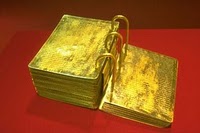Help in Understanding
the Book of Mormon
By Grant Hardy
Meridian Magazine
https://latterdaysaintmag.com/

A List of Interesting Points
There are dozens of names to keep straight (including four different Lehis, four Nephis, and four Jacobs).
Moroni was the author of Mormon 8-9 while Moroni 7-9 was actually composed by Mormon.
The narrators - Nephi, Mormon, and Moroni - wrote from their individual circumstances and personalities.
The book of Alma, divides rather neatly into seven major sections:
A. The Amlicite Rebellion (2:1 - 3:20)
B. Alma 2 and the Nephite Reformation (4:6 - 16:21)
C. The Missionary Journeys of the Sons of Mosiah 2 (17:5 - 27:15)
D. Alma 2's Mission to the Zoramites (31:1 - 35:14)
E. Alma 2's Testimony to his Sons (35:15 - 42:31)
F. The Zoramite War (43:1 - 44:24)
G. The Amalickiahite Wars (46:1 - 62:41)
Furthermore, last of the Amalickiahite Wars was fought on two fronts simultaneously: Alma 52-55 and 59-62 take place in the east with Captain Moroni, while Alma 56-58 follows events on the western front with Helaman 2 and the stripling warriors.
Unlike the Hebrew Bible, where the narrators are anonymous, the writers of the Book of Mormon openly identify themselves and tell us often of their ambitions, their editorial labors, and their personal lives.
Like all authors who tell stories (including people writing family histories), Nephi could choose from a number of different narrative techniques. For instance, he had to decide when to quote directly and when to paraphrase.
First Nephi was written some thirty to forty years after his family left Jerusalem. If Nephi had been a teenager at the time, as seems likely, he is now writing in his forties or fifties.
Laman and Lemuel seem like flat, two-dimensional, entirely predictable figures, almost as if they were a single person, but only because Nephi, as the narrator, has made them so. Remember that by the time Nephi composed the Small Plates, he had full knowledge that life in the Promised Land had soured, that there had been an irreparable breach with those brothers, and that his closest relatives had spent years trying to kill each other. He wants to make it as clear as possible to his readers why things turned out the way they did, and he therefore simplifies what were undoubtedly many years of complex family interactions.
A close reading of the Book of Mormon reveals that Mormon and Moroni have somewhat different perspectives - Mormon is a conscientious historian who believes that the facts themselves can persuade his readers, while Moroni tends to think that historical evidence is less important than the witness of the Spirit.
The record of the Jaredites was discovered by Limhi's people at Mosiah 8 and then translated by King Mosiah (Mosiah 28). At that point in the narrative (28:19), Mormon promised that he would eventually provide a synopsis, but apparently he found it difficult to fit the Jaredite material into the overall scheme he had for his history of the Nephites (remember, the Jaredites were not even from the House of Israel). Mormon died before the task was completed and left it to his son, Moroni, who had a somewhat less rigorous
conception of history. Moroni included the book of Ether as a sort of appendix to his father's work.
Some readers are simply curious or interested for academic reasons. If people want to read the Book of Mormon as fiction or as world scripture, I welcome that. I think the book is impressive from any perspective. Some historians have been eager to analyze it in nineteenth-century terms. Yet it is important for even non-believers to take the book on its own terms, and for scholars to apply to it the tools of literary criticism, which can enrich the understanding of outsiders and saints alike.
My main point is not to prove that Joseph Smith couldn't have written the Book of Mormon or to try convincing anyone of its
historical claims; rather, I simply argue that the book is much more interesting than many people have assumed, and that a close reading of its form and content can yield valuable insights.
Sometimes even as Latter-day Saints, reading from a position of faith, we have not always been aware of all the strengths of our scriptures.
(edited by David Van Alstyne)
Home
/
For Latter-day Saints
|
